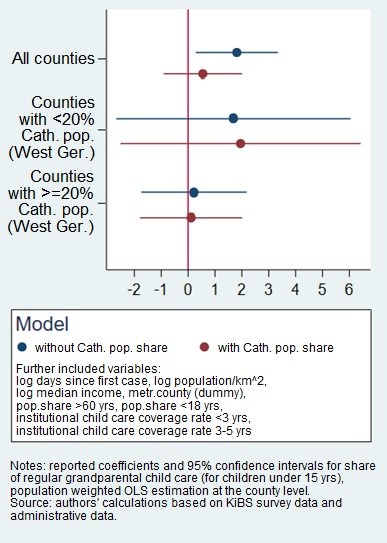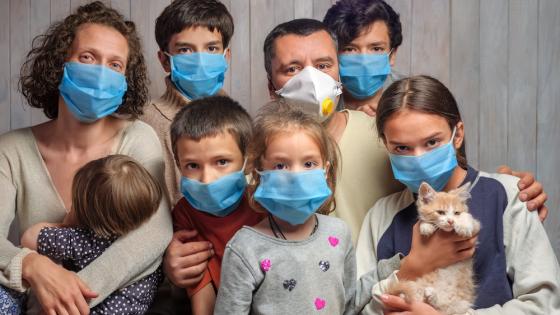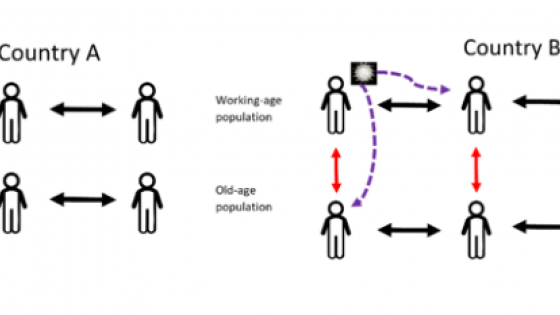Since the beginning of the pandemic, many studies have analysed the driving forces behind the spread of Covid-19. This includes the role of intergenerational relations, and particularly contact between grandparents and their grandchildren, in potentially increasing the risk of infection and Covid-19 mortality (e.g. Aparicio and Grossbard 2020, Arpino et al. 2020, Balbo et al. 2020, Bayer and Kuhn, 2020). Due to substantially higher mortality rates of older persons infected with Covid-19, early studies in 2020 pointed to the vulnerability of certain regions due to their demographic characteristics (Kashnitsky and Aburto 2020) as well as the prevalence of strong intergenerational relations (Balbo et al. 2020). Aparicio and Grossbard (2020) and Bayer and Kuhn (2020) present evidence that the frequency of intergenerational co-residence at the regional level is positively related to Covid-19 fatalities per capita. However, Arpino et al. (2020) were unable to confirm these findings based on their analysis of SHARE data for different European countries, and Belloc et al. (2020) derive the opposite conclusion based on data for Italian regions.
In a recent study (Boll and Nikolka 2020), we analyse the potential relationship between grandparental childcare support and Covid-19 infection rates in Germany using detailed regional-level administrative and survey data. We draw on a comprehensive register of Covid-19 infections among the population aged 60 years or older registered by the local German health authorities up to 23 March 20201 and link these data to aggregated survey data on regular grandparental childcare support at the county level.
Theoretical considerations
Since grandparental childcare (henceforth, GPCC) is only one source of social contact, the hypotheses that structure our empirical investigation focus on potential drivers of GPCC and, at the same time, on extra-familial sources of social contact which might be confounding variables when analysing the link between GPCC and the observed overall infection rates in the elderly population at the county level. We argue that GPCC should be shaped by the household context, the availability of institutional childcare facilities (H1), and norms (i.e. reciprocity norms and the value attributed to intergenerational relations) (H2). Regarding the household context, we expect that working parents, the age of a child, and the use of institutional childcare arrangements should have an impact on the likelihood of using GPCC. Concerning norms, we expect Catholic denomination to be related to stronger intergenerational family ties and should therefore increase the propensity of grandparental childcare, as a central foundation of Catholic social thought is the ‘subsidiary concept’ emphasising the role of intra-family solidarity for social support (e.g. Gundlach 1964, Althammer 2013).
Regarding infection rates among the population aged 60 years and older at the county level, we postulate that the infection path in terms of time since the first patient increases the number of infections (H3). We further hypothesise that infection rates increase with population density (H4). Moreover, we suggest that children enrolled in public childcare as well as parents engaged in job-related social contact could provide a source of infection for the (grand-)parents they interact with. Therefore, we use institutional childcare coverage rates for children aged below 3 and between 3 and 5, respectively (H5), as well as (log) median income as a proxy for economic activity (H6) as explanatory variables in the infections equation.2 Regular GPCC could be associated with higher infection rates due to a higher risk exposure of elderly people who take care of their grandchildren (H7).
Beyond the indirect channel via GPCC, Catholic denomination might impact infections directly via a network mechanism related to the private (non-job) sphere (H8). In particular, religious events – for example, worship and religiously motivated celebrations with a high number of participants such as weddings – are suspected of driving infection numbers (Lee et al. 2020, Salvador et al. 2020). Moreover, the German Rhineland regions (Rhineland-Palatinate and North Rhine-Westphalia), where many Catholic people live, are well known for their Carnival processions which take place in February. Finally, due to a higher contact frequency among younger people, a high population share of minors and a low share of elderly people (aged 60 or over) should increase infection rates (H9). As further control variables we include the share of foreign nationals per county as well as a dummy variable for eastern German counties, which belonged to the former German Democratic Republic.
Empirical results
In our empirical analysis, we draw on a weighted sample of individual-level survey data from the 6th wave of the Kinderbetreuungsstudie (KiBS), which was collected by the German Youth Institute in 2017 (Alt et al. 2020, Aust et al. 2018) and contains information on the use of regular GPCC.3 A first descriptive analysis with our aggregated survey data reveals considerable regional variation in regular GPCC in Germany. GPCC is less common in northern than in southern states in Germany, and also less common in the ‘city-states’ of Hamburg, Berlin and Bremen. Administrative data on registered infections per 1,000 inhabitants until 23 March 2020 in the population aged 60 years or older (RKI 2020) also shows substantial regional variation across federal states in Germany – ranging from 24.2 (Mecklenburg-Western Pomerania) to 185.6 (Baden-Wuerttemberg). Finally, we additionally use administrative data on sociodemographic and economic characteristics at the county level as provided by the INKAR (2020) database.
In a first multivariate analysis, we estimate the probability of regular GPCC with a weighted sample of 33,259 children in the target population aged 0 to 14 in Germany reached by the KiBS survey. The dependent variable is whether a child in the sample is regularly taken care of by a grandparent. The micro-level results confirm our expectations (H1) – children with single or working parents, children aged 3-5, and children without institutional childcare arrangements are more likely to be taken care of by grandparents. Moreover, our results reveal that the population share of Catholic population at the county level is strongly positively associated with the probability that the grandparents are involved in childcare support, confirming our hypothesis H2.
In a second stage, we conduct analyses at the county level linking aggregated information on regular grandparental childcare support for children aged under 15 from KiBS at the county level4 with regional administrative statistics and the logarithm of infection rates among the elderly, as introduced above. The log-days since the first registered case of Covid-19 in a county are significantly positively associated with infection rates, which supports our hypothesis H3. Counties with higher median income and metropolitan counties exhibit higher infection rates in the old-age population, providing support for our hypotheses H4 and H6. Childcare coverage rates and the population shares of non-Germans and elderly people, respectively, lack significant associations with county-specific infection rates, thus not confirming hypotheses H5 and H9.
When controlling for the above-mentioned variables, our regressions reveal a statistically significant positive relationship between log Covid-19 infection rates and the percentage share of grandparental childcare in a county, which is in support of hypothesis H7. However, when including the share of Catholic population, we observe that this variable is highly positively correlated with our dependent variable (confirming hypothesis H8) and that it absorbs the effect of grandparental childcare. That is, H7 has to be discarded in this specification. We cannot measure the non-job network channel directly, but we suggest that in counties lacking a significant share of Catholics, the out-of-family mechanism should be relatively weaker than the within-family mechanism, attributing regular GPCC a stronger role in this environment. Conversely, in counties exhibiting a significant share of Catholics, we expect the regular GPCC effect to be relatively weaker and the out-of-family channel to be relatively stronger. To disentangle GPCC from the out-of-family channel, we divide our sample into two subsamples, with the first comprising counties with a population share of Catholics below 20% and the second with the remaining counties.5 The coefficient for regular GPCC is not significant in either of the two county groups. If anything, the data point to the importance of extra-familial ties – the regression coefficient for regular grandparental support is larger in those counties with a Catholic share of less than 20% (Figure 1).
Figure 1 Regressions of log infections rates (60+) on regular grandparental childcare
Conclusion
Adding to the evolving literature on the role of intergenerational relations in the spread of Covid-19, we study the potential link between regular grandparental childcare (GPCC) and Covid infection rates at the German county level. Our results show that a significant association between the two vanishes as soon as the Catholic population share is accounted for. Although being Catholic increases the likelihood of grandparental childcare in a family, our regressions of infection rates on a range of county-related covariates show that the Catholic effect drives infection rates even if the population share using GPCC effect is accounted for. We motivate this out-of-family channel with social networks related to religious beliefs. However, we are not able to measure these effects directly, so other unobserved region-specific factors could also play a role here. Our findings cast doubt on simplistic narratives postulating a link between intergenerational contact and infection rates.
References
Albertini, M and M Kohli (2013), “The generational contract in the family: An analysis of transfer regimes in Europe”, European Sociological Review 29(4): 828-840.
Alt, C, J Anton, B Gedon, S Hubert, K Hüsken, K Lippert, and V Schickle (2020), “DJI-Kinderbetreuungsreport 2019. Inanspruchnahme und Bedarf aus Elternperspektive im Bundesländervergleich”, DJI.
Althammer, J. (ed.) (2013), Caritas in veritate. Katholische Soziallehre im Zeitalter der Globalisierung, Duncker & Humblot.
Aparicio, A and S Grossbard (2020), “Intergenerational residence patterns and COVID-19 fatalities in the EU and the US”, IZA Discussion Paper No. 13452.
Arpino, B, V Bordone, and M Pasqualini (2020), “No clear association emerges between intergenerational relationships and COVID-19 fatality rates from macro-level analyses”, Proceedings of the National Academy of Sciences 117(32): 19116-19121.
Aust, F, J van den Burg, D Hess, and B Knecht (2018), “Methodenbericht - Kinderbetreuungsstudie 2017 und Zusatzuntersuchung ‚Pilotstudie: Räumliche Mobilität von Familien und Kindern in Zeiten der Digitalisierung”, infas.
Balbo, N, F C Billari, and A Melgrano (2020), “The strength of family ties and COVID-19”, Contexts, American Sociological Association.
Bayer, C and M Kuhn (2020), “Intergenerational ties and case fatality rates: a cross-country analysis”, VoxEU.org, 20 March.
Belloc, M, P Buonanno, F Drago, R Galbiati and P Pinotti (2020), “Cross-country correlation analysis for research on COVID-19”, VoxEU.org, 29 March.
Boll, C and T Nikolka (2020), “Rightly blamed the 'bad guy'? Grandparental child care and Covid-19”, Covid Economics 62: 155-175.
Gundlach, G (1964), Die Ordnung der menschlichen Gesellschaft, Vol. 2, Cologne.
Hippich, M, L Holthaus, R Assfalg et al. (2020), “Public health antibody screening indicates a six-fold higher Sars-CoV-2 exposure rate than reported cases in children”, Med 2: 1-15.
Indikatoren und Karten zur Raum- und Stadtentwicklung (INKAR) (2020) Ausgabe 2020. Hrsg.: Bundesinstitut für Bau-, Stadt- und Raumforschung (BBSR) im Bundesamt für Bauwesen und Raumordnung (BBR), Bonn.
Kashnitsky, I and J M Aburto (2020), “COVID-19 in unequally ageing European regions”, World Development.
Laxminarayan, R, B Wahl, S R Dudala, K Gopal, S Neelima, K J Reddy, J Radhakrishman, and J A Lewnard (2020), “Epidemiology and transmission dynamics of COVID-19 in two Indian states”, Science 370(6517): 691-697.
Lee, E C, N I Wada, M K Grabowski, E S Gurley, and J Lessler (2020), “The engines of Sars-CoV-2 spread”, Science 370(6515): 406-407.
Robert Koch-Institut (RKI) (2020), “Fallzahlen in Deutschland”, dl-de/by-2-0.
Salvador, C, M Berg, Q Yu, S M Alvaro, and S Kitayama (2020), “Relational mobility predicts faster spread of COVID-19: a 39-country study”, Psychological Science 31(10): 1236-1244.
Endnotes
1 This is the date when the first official policy restrictions were announced in Germany as a response to the accelerating spread of Covid-19. However, our results are robust to using infection numbers until 30 September 2020 instead.
2 Regarding institutional childcare, it is a matter of debate whether children in institutional care could also be a driver of infections in the population. Recent studies argue that infected but asymptomatic children are likely to be a source of further Covid-19 contagion (Hippich et al. 2020, Laxminarayan et al. 2020).
3 KiBS contains information on whether grandparents provide regular childcare support for a child. Alternative answer options in the survey questionnaire were “only irregular use” and “no use”.
4 We only include counties with at least 30 individual-level observations. Results are qualitatively similar without minimum number of observations restriction or when restricting to at least 20 or 50 observations per county. We apply survey non-response weights as described in Alt et al. (2020).
5 We selected a threshold of 20% Catholic population share as this divides our sample roughly in half. Since Eastern Germany lacks representation in the first group, we restrict both subsamples to West German counties.




